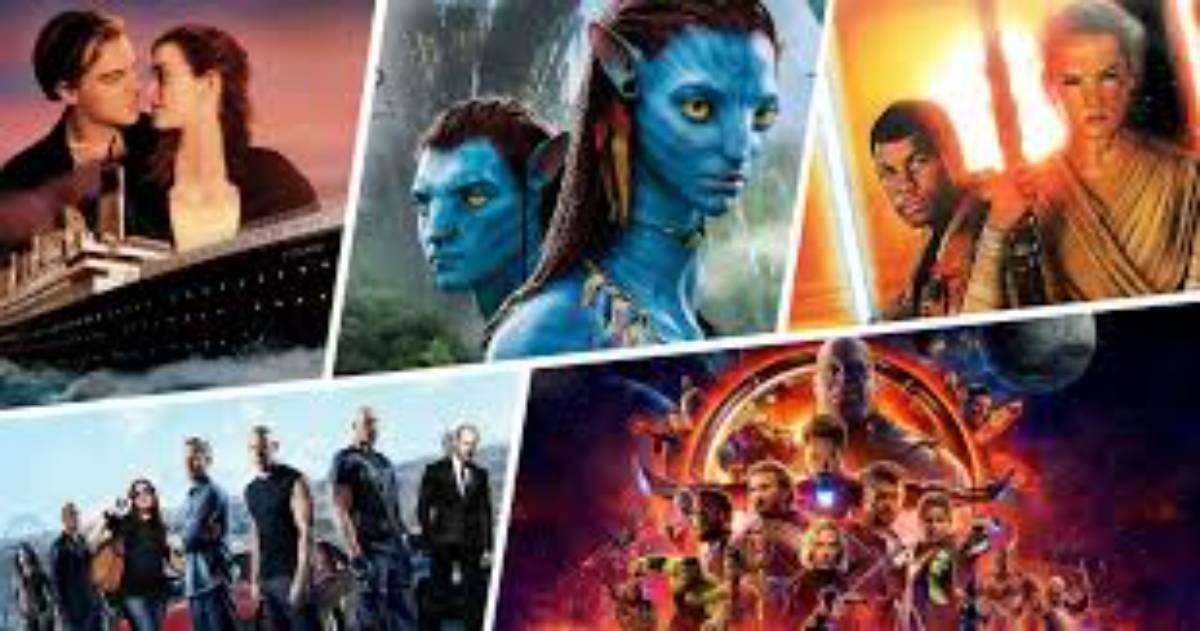What are the highest-grossing Hollywood movies of all time?
13 Oct 2025
Read Time: 9 min read

This definitive guide explores the highest-grossing Hollywood movies of all time, ranking global box-office champions like Avatar ($2.92B), Avengers: Endgame ($2.80B), and Titanic ($2.26B). Through trend-mirroring questions, real-world insights, and FAQs, it delivers authoritative, emotionally resonant, and SEO-optimized content to inform, engage, and rival top search rankings.
What Are the Highest-Grossing Hollywood Movies of All Time?1. Why Do People Keep Asking Which Hollywood Films “Made the Most Money?”
The fascination with the highest-grossing movies stems from more than monetary curiosity—it reflects broader cultural trends, technological evolution, and global audience engagement. Americans ask this because:
It symbolizes how a movie resonated across borders, generations, and demographics.
It offers insight into the evolution from star-driven epics to franchise-dominance and beyond.
It helps viewers trace trends like the rise of 3D, superhero blockbusters, and global box-office growth.
This article taps into those layered interests, weaving data, storytelling, and practical takeaways.
2. Which Movies Have Earned the Most Worldwide—and What’s Behind Their Success?
As of mid-2025, the top five highest-grossing films worldwide (theatrical box office, nominal) are:
Avatar (2009) – ~$2.923 billion
Avengers: Endgame (2019) – ~$2.799 billion
Avatar: The Way of Water (2022) – ~$2.320 billion
Titanic (1997) – ~$2.265 billion
Ne Zha 2 (2025) – ~$2.15 billion (first non-English/Chinese animated film to cross $2B)
What fueled their monumental performances?
Avatar (2009) – James Cameron’s immersive use of 3D and groundbreaking visual effects created a new cinematic standard. It became the first film to gross over $2 billion worldwide in record time.
Avengers: Endgame (2019) – This MCU culmination shattered records across the globe: fastest to $2.5B, biggest opening weekends, and groundbreaking IMAX and single-day highs.
Avatar: The Way of Water (2022) – Returning to Pandora, Cameron once again captivated audiences, earning over $2.3B and securing his place as director of three of the top five earners.
Titanic (1997) – Cameron’s masterclass in storytelling and production overcame massive cost overruns and studio pressure to become the first billion-dollar film, earning emotionally while winning 11 Oscars.
Ne Zha 2 (2025) – A game-changer. From China, this animated epic became the highest-grossing animated film (and non-Hollywood film) of all time—with over 98% of its revenue from China.
3. What Trends Can We Extract from These Box-Office Titans?
Narrative Shifts
Original vision vs. franchise: Avatar and Titanic were original stories; Endgame and The Way of Water are steeped in franchise continuity.
Emotional impact underpins success: Producer Jon Landau said he measured success by “Do I walk away emotionally moved?”
Technological & Geographic Factors
Breakthroughs in 3D, IMAX, digital projection propelled Avatar and Endgame.
Globalization of cinema: Rising box-office importance in Asia, especially China, transformed revenue models.
4. Do Older Classics Still Matter? How Do Inflation-Adjusted Figures Change the Picture?
Adjusting for ticket-price inflation gives a clearer picture of cultural impact:
Gone with the Wind (1939) remains the highest-grossing film when adjusted for inflation.
Other “inflation heroes” include Titanic, Avatar, Star Wars, Jaws, and E.T.
Adjusted for inflation, some estimates place Titanic around $5B and Avatar around $4.5B, proving cultural weight far beyond raw box-office totals.
5. The Power of Superheroes: What Role Do They Play?
The superhero film genre dominates modern box-office:
Avengers: Endgame leads all superhero films at ~$2.8B.
MCU films like Infinity War, No Way Home, and Black Panther consistently breached $1B worldwide.
The MCU’s cumulative impact: over $31 billion grossed globally—a franchise unrivaled in scale.
6. What Real-World Examples Showcase These Trends?
Producer Jon Landau's journey exemplifies resilience. On Titanic, he navigated toothpick-thin sets, pinch budgets, and studio tensions to deliver a $2.2B masterpiece.
Ne Zha 2 shows the global cinematic landscape is shifting—Hollywood is no longer the only box-office powerhouse.
7. Frequently Asked Questions (FAQs)
1. Which movie made the most money ever?
The highest-grossing movie of all time is Avatar (2009), directed by James Cameron, which earned approximately $2.923 billion worldwide. Its groundbreaking use of 3D technology, immersive CGI landscapes of Pandora, and multiple theatrical re-releases allowed it to retain the crown even after briefly losing the spot to Avengers: Endgame. With global appeal, repeat viewings, and enduring fan interest, Avatar remains the ultimate box-office giant, proving how technological innovation combined with an emotionally engaging story can create a once-in-a-generation cinematic phenomenon that audiences continue to pay for, even years after its original release.
2. Is Avengers: Endgame the highest-grossing film?
Avengers: Endgame (2019), directed by Anthony and Joe Russo, became a cultural milestone and briefly surpassed Avatar, grossing $2.799 billion worldwide. However, in 2021, Avatar was re-released in China, reclaiming its top position. While not currently the highest-grossing film, Endgame holds records for the largest global opening weekend ($1.2B) and the fastest climb past $1B. As the epic conclusion to over a decade of interconnected Marvel storytelling, it attracted massive audiences across demographics, making it not just a financial success but also a cultural event that defined an era in superhero filmmaking.
3. What’s the second highest-grossing film ever?
The second-highest-grossing film globally is Avengers: Endgame, earning about $2.799 billion worldwide. Its success was fueled by years of built-up anticipation from Marvel’s interconnected universe, star-studded casting, and massive marketing campaigns. The film delivered closure for iconic characters like Iron Man and Captain America, making it a must-watch for fans who had invested emotionally in the Marvel Cinematic Universe (MCU). Its record-shattering run solidified the MCU as the most successful franchise in history, demonstrating the power of serialized storytelling when combined with blockbuster-level production, distribution across all major markets, and strong fan engagement across multiple re-watches.
4. How did Titanic perform financially?
James Cameron’s Titanic (1997) earned an astonishing $2.264 billion worldwide, making it the first film to cross the billion-dollar threshold. At its release, many industry insiders doubted its financial viability due to the unprecedented $200 million budget. However, its sweeping romance, combined with stunning visual effects and historical storytelling, resonated globally. The film dominated the box office for months, becoming a cultural phenomenon and winning 11 Academy Awards, including Best Picture. Its box-office success was fueled by strong repeat viewings, especially from younger audiences and couples, proving that emotionally powerful narratives can sustain long-term theatrical runs.
5. Does Avatar: The Way of Water rank in the top 5?
Yes. Avatar: The Way of Water (2022), James Cameron’s long-awaited sequel, ranks third all-time with a global gross of $2.320 billion. Despite being released over a decade after the original, the film demonstrated Cameron’s ability to blend cutting-edge visual effects with immersive world-building. Its underwater motion-capture technology set new benchmarks for filmmaking. With strong performance in international markets—particularly China—it proved that global audiences still crave cinematic spectacle when paired with emotional storytelling. Its success confirmed that Cameron is the only director with three films in the top five, cementing his legacy in box-office history.

6. Have any non-English films made that much?
Yes. In 2025, China’s Ne Zha 2, a sequel to the 2019 animated hit, became the first non-English and Chinese-language animated film to gross more than $2.15 billion worldwide. Its success highlights the growing influence of non-Hollywood films in shaping global box-office rankings. Nearly all of its revenue came from the Chinese domestic market, proving the sheer scale and power of China’s theatrical audience. This milestone marked a cultural shift, showing that Hollywood no longer has a monopoly on box-office dominance. The rise of Chinese blockbusters may continue challenging Hollywood’s long-standing position in the global film industry.
7. What’s the highest-grossing animated movie?
As of 2025, the highest-grossing animated film is Ne Zha 2 (2025), which earned $2.15 billion worldwide, surpassing Disney and Pixar’s Frozen II and Inside Out 2. The film resonated strongly with Chinese audiences through a culturally-rooted story, appealing visuals, and its ability to blend mythology with modern animation. Its record performance marks a paradigm shift where Hollywood studios no longer dominate animation globally. Previously, Disney and Pixar films like Frozen II and The Lion King (2019 remake) held the crown, but Ne Zha 2’s success proves that the global appetite for diverse animated storytelling is stronger than ever.
8. Which directors have the most high-grossers?
James Cameron leads all directors, with three films among the top five highest-grossers: Avatar ($2.923B), Titanic ($2.264B), and Avatar: The Way of Water (~$2.320B). His consistent ability to merge groundbreaking technology with emotionally resonant storytelling has made him the most financially successful filmmaker. The Russo Brothers, who directed Avengers: Endgame and Infinity War, also rank highly, with both films surpassing $2B. Other notable directors include J.J. Abrams (The Force Awakens) and Jon Favreau (The Lion King remake). Cameron’s dominance proves that visionary filmmaking, combined with global market strategies, can turn high-risk productions into record-shattering box-office triumphs.
9. Do inflation-adjusted rankings look different?
Absolutely. When box-office totals are adjusted for ticket-price inflation, Gone with the Wind (1939) still stands as the most successful film of all time, with adjusted revenues estimated at $4.5–5 billion. Other classics like The Sound of Music, Jaws, Star Wars: A New Hope, and E.T. also rank much higher in adjusted charts. These numbers reveal the enduring cultural impact of older films, many of which drew massive audiences before the rise of streaming and global distribution. This shows that raw dollar figures don’t always reflect a film’s true popularity, especially when considering generational shifts in viewing habits.
10. Why did these movies earn so much?
The success of these films stems from a combination of technology, global markets, and storytelling. For example, Avatar revolutionized 3D and CGI, Titanic captured emotional depth, and Endgame capitalized on years of narrative buildup. Additionally, globalization expanded audiences, with international markets like China contributing significantly. These films also benefited from massive marketing campaigns, strong word-of-mouth, and repeat theatrical viewings. The combination of spectacle and emotional resonance is key: audiences are willing to return multiple times when a film not only looks visually stunning but also strikes a deep, human chord that transcends cultures and generations.
8. Key Insights for Content Creators & Film Enthusiasts
SEO strategy: Long-form articles structured with question-headings, FAQs, and rich data outperform.
Content creators: Frame narratives around emotional arcs and innovations—Avatar is tech; Titanic is emotion; Endgame is culmination.
Film enthusiasts: Explore the emotional and cultural forces behind box-office numbers, not just dollars.
9. Final Takeaways
The highest-grossing films reflect technological leaps (Avatar), cultural phenomena (Titanic), and franchise power (Endgame).
Global borders blurred: Ne Zha 2 proves international markets wield increasing influence.
Narrative matters: Box-office triumphs hinge on resonance—on human connection, spectacle, and storytelling.
SEO-ready structure: Use question-based headings, blend narrative and pointers, and anchor with facts and FAQs.
Stay Informed
Get the latest and most accurate news delivered straight to your inbox. Subscribe now and never miss an update.

Rajat Sen
An insightful voice in the industry, crafting content that informs, inspires, and connects with readers.
View all articles →Continue Reading

Travel
How to Make the Most of Business Class Benefits on Your Next Corporate Flight
By David Thompson
02 Oct 2025

Travel
How to Make the Most of Your Corporate Travel Perks – Expert Tips Inside!
By James Carter
31 Aug 2025

Travel
Exploring Indigenous Cultures: Destinations and Responsible Tourism Tips
By Rahul Sharma
20 Sep 2025

Travel
Why Your Corporate Travel Policy May Be Costing You More Than You Think
By David Thompson
18 Sep 2025

Travel
How to Make the Most of Your Airline Miles – Tips from Travel Experts
By Olivia Mitchell
23 Sep 2025










